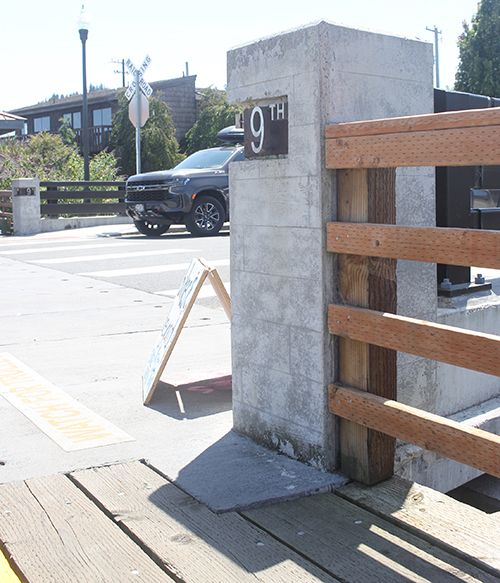
Historic Preservation as a Tool to Promote Community
By Brittany Hobbs
Brett Estes’ passion for historic preservation -- and the City of Astoria -- shine through in both the words he speaks and the stories he tells. Jovial and charismatic, he’s no rookie. He has spent over a decade serving in public office in Astoria, and started on his historic preservation journey long before that.
Originally from Texas, Brett took the opportunity to study historic preservation as part of his master’s degree. Scholastic endeavors eventually led him to a unique internship in Fredericksburg, Texas. There he was tasked with aiding in the creation of preservation ordinances for downtown commercial buildings which were greatly in need of protection. He also helped initiate ordinances for some very special residences: the Sunday Houses. These small but charming buildings date back to the mid- to late-1800’s, when adventurous farmers purchased their first plots of land. Patches of land were sold as a package deal: along with rural farm plots came a tiny city plot. Families would travel from their rural farms to homes on their city plots on Saturdays, spend Sundays attending church and shopping, then head back home. These modest houses were seldom built by prosperous folk, and the farmers who built them were judicious with materials and construction. Many structures were built from local limestone, while others were constructed using techniques brought over from Germany, known as fachwerk. Most of the Sunday Houses were small and featured exterior staircases to preserve precious indoor square footage. Some were adorned with simple Victorian accents. Brett worked with the Fredericksburg community to create ordinances for these historic treasures. Perhaps foreshadowing what was to come, this internship would not be Brett’s last foray into small town policy advising.
Brett was accustomed to the hustle and bustle of the metropolis known as Dallas-Fort Worth, a region with twice the population of the entire state of Oregon. When he first relocated from Texas to Oregon, he lived in Hillsboro. But soon he found himself increasingly drawn to Astoria, planning multiple trips to the coastal city.
On the fateful morning of his last trip to Astoria as a visitor, Brett opened the local newspaper to see a job listing for Community Development Director. Some might say “the rest is history,” as Brett is still serving the Astoria community some 14 years later. In 2014, he became City Manager, a role he continues in today.
As a newcomer to Astoria, Brett took time to listen carefully to the heartbeat of the city…that is, the heartbeat of the locals, not the visitors. In a city that has remained at a consistent population of 10,000 for over a century, Brett is happy to explain the importance of putting the needs of the locals first: this approach retains community.
Astoria keeps its delicate balance between pretty and gritty, careful not to tip too far into the category of quaint. It refuses to become a frilly beach town that caters to weekenders. Because of this, it remains a city with a vibrant sense of place, with houses inhabited by community members, not vacationers. This not only helps maintain the local population, it avoids creating a greater deficit in available affordable housing.
In his role as City Manager, Brett works to assess the needs of his community, while examining the historic significance that helps define Astoria. With 70 percent of housing stock built before 1950, and a robust Historic Registry, maintaining historic integrity flows through Astoria’s veins.

Recently, Brett worked on necessary upgrades to Astoria’s Riverwalk, investigating historic precedents and deferring to the needs of the community. The Riverwalk was originally built for locals, so Brett saw great importance in retaining that intention. Today, you can see the efforts of his advocacy in the concrete pads and street signs that line the historic Riverwalk.
Brett is also passionate about exposing inexcusably overlooked histories, such as that of Astoria’s large Chinese population. Historically, these individuals worked tirelessly in Astoria’s canneries until technological innovations abruptly usurped their positions. Once their skills were no longer required in the canneries, signs directed at the Chinese were placed along the waterfront indicating that they were no longer welcome. This uncomfortable history was not spoken about or readily discussed for decades. However, in May 2014, Astoria celebrated the unveiling of The Garden of Surging Waves, a park with a series of art installations that shed light on the history of Astoria’s Chinese residents. The sculptures show respect for these previously uncelebrated residents and their stories. One large piece displays oral histories shared by contemporary citizens. Brett notes the importance of this first step of representing a more complicated and nuanced history of Astoria - a history that is not whitewashed but does include all members of the community.
When not performing his duties as Astoria City Manager, or working on restoring his 1905 historic home, Brett can be found sharing his expertise on the Policy Board here at Restore Oregon. He also generously volunteers his time on our Board of Directors, using his board position to learn about issues facing communities across the state, and compare notes with preservationists in other small cities, adding to his arsenal of preservation tools and knowledge.

